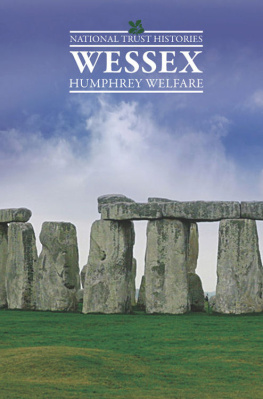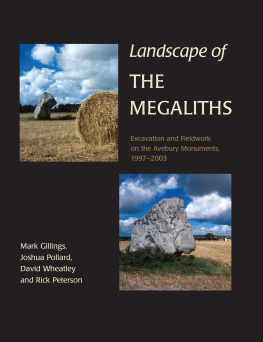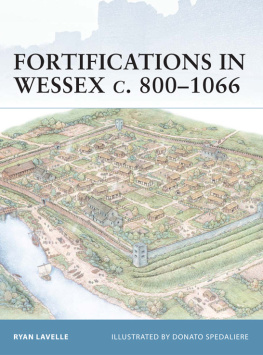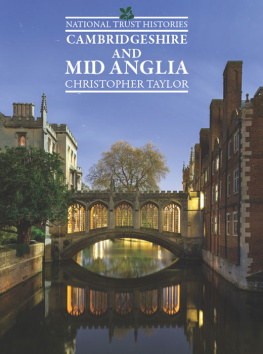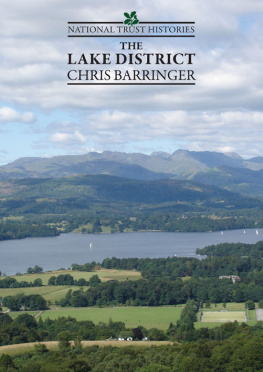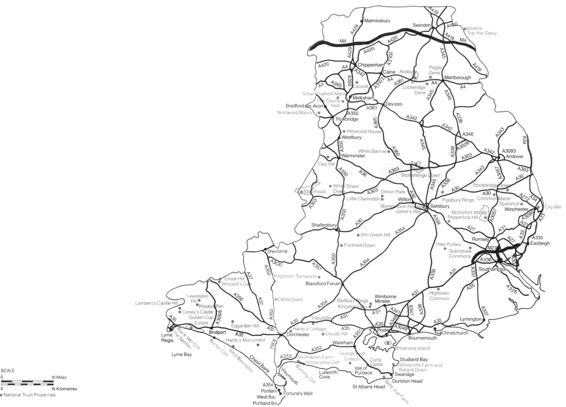
In these Wessex nooks the busy outsiders ancient times are only
old; his old times are still new; his present is futurity.
Thomas Hardy, Far From the Madding Crowd
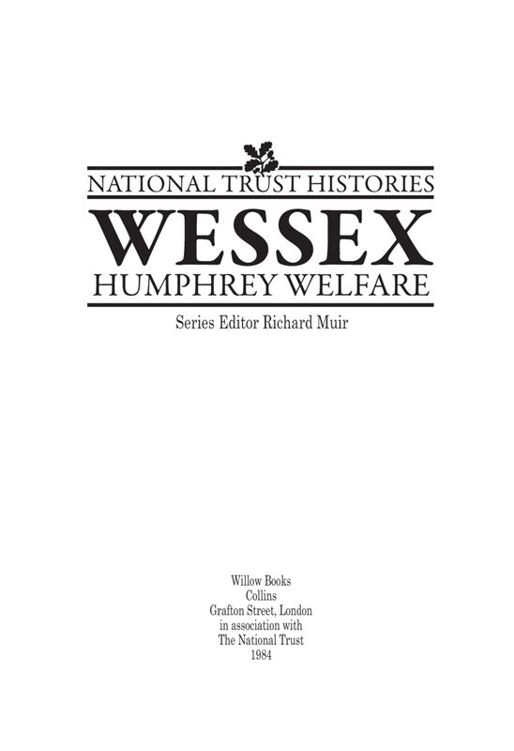
RETRO CLASSICS
is a collection of facsimile reproductions
of popular titles from the 1980s and 1990s
National Trust Histories: Wessex
was first published in 1984
by William Collins & Co Ltd.
Re-issued in 2015 as a Retro Classic
by G2 Rights
in association with Lennard Publishing
Windmill Cottage
Mackerye End
Harpenden
Hertfordshire
AL5 5DR
Copyright 1984 Humphrey Welfare and Lennard Books Ltd
ISBN 978-1-78281-145-9
Editor: Michael Leitch
Designed by David Pocknells Company Ltd
Printed and bound by Lightning Source
This book is a facsimile reproduction of Wessex
as it was originally published in 1984.
No attempt has been made to alter any of the wording
with the benefit of hindsight, or to update the book in any way.
C ONTENTS
Shape of the countryside;
Neolithic monuments long barrows and causewayed enclosures;
The military conquest;
Advance of the Saxons;
Castles of Wessex;
Coastal fortifications;
The seaside;
E DITORS INTRODUCTION
Wessex takes its name from the West Saxon kingdom which, in the reign of Alfred the Great and his successors, provided the core from which English statehood and nationalism could expand. This was not the first time that Wessex had assumed a central position on the British stage, for in the Neolithic and early Bronze Age periods it emerged as a rich and innovative region with a sophisticated and dynamic organization which is still proclaimed by world-famous monuments such as Stonehenge, Avebury and Silbury Hill.
At the mention of the word Wessex, the thoughts of most readers will turn to Stonehenge and to the regional novels of Thomas Hardy. Sadly, the ploughing-up of the traditional downland pastures and the removal of ancient hedgerows, woodlands and wetlands from the vales have radically changed some of Hardys windswept grasslands and dairy-rich lowlands. Even so, Wessex still contains some fine countryside and a wealth of monuments of different ages. Beside the glories of the prehistoric legacy, the area contains such great churches as Salisbury Cathedral and Sherborne Abbey, famous mansions such as Wilton and Longleat, remarkable fortresses such as Portland and Corfe Castles, fascinating villages such as Lacock and Milton Abbas as well as important industrial monuments such as those in Bradford-on-Avon and Swindon.
In this book Humphrey Welfare explains the creation of the Wessex landscape and introduces a wonderful assemblage of monuments and settlements to demonstrate that the region contains an inexhaustible legacy of interesting places, some of them well- known and much-visited, but many more which are usually overlooked by the visitor. The author is a graduate of Newcastle University and is employed as an Investigator with the Royal Commission on Historical Monuments. He has a special understanding of the antiquities of the Wessex landscape as for several years, preceding his very recent transfer to the NorthEast, he was based in Salisbury and engaged in surveying and recording the monuments of the area. He is the author of several specialist publications on late prehistoric and Roman Britain and is the co-author of the National Trust Guide to Prehistoric and Roman Britain.
Richard Muir
Great Shelford, 1983
T HE LANDSCAPE AND EARLY MAN
Wessex exists chiefly in the mind, defying exact definition of its boundaries. For many people it is the chalk downland, for others the landscape of Thomas Hardy and W. H. Hudson, a rich Bronze Age culture, or an Anglo-Saxon kingdom. It is all these things, but in this book Wessex is regarded as Dorset, Wiltshire (excluding the Cotswold edge and the Thames Valley north of Swindon), and Hampshire west of Winchester. The New Forest is included but the Isle of Wight, although geologically a part of Wessex, has a wholly separate identity.
Two centuries ago the majority of the British population lived in the countryside, enjoying an intimate relationship with the land. In many regions of England these close ties have been swept away, but one of the great charms of Wessex is that it is still predominantly a rural area, where the inhabitant or returning native can feel near to his roots.
The region contains some of the greatest variety of countryside in southern England: whaleback chalk downland, warm and fertile clay vales, the heaths and woodlands of south-east Dorset and the New Forest, the high cliffs bounding Lyme Bay, and the sands and mudflats around Poole Harbour.
This variety pleases the eye but it is more deeply founded than that. It is all too easy for those not directly connected with the land to forget how much the underlying geology affects the way we live. It dictates the form of the landscape; the natural flora and fauna; the fertility of the soil; the distribution of arable farms, of pasture, woodland and heaths; the availability of water supplies and the position of settlements; the success of extractive and many manufacturing industries; the building materials used locally and thus, until very recently, even the colours of our villages and towns.
For many people, however, the Wessex landscape is synonymous in the minds eye with chalk downs and combes: smoothly rounded contours, flint-studded arable fields and closely-cropped sheep pastures, with some of the higher hills crowned with a prehistoric hill fort or a clump of trees. Chalk does indeed predominate, for it forms the foundation of Salisbury Plain, of central Hampshire and the Marlborough Downs, with an outstretched arm extending southwards into Dorset.

The chalk downs as they used to be: Heddington to the north of Devizes in the early eighteenth century. The high pastures contrast with the small enclosed fields and woods of the clay lowlands.
The geology of Wessex may be imagined as a white apron the chalk held out to gather the newer and softer rocks of the Hampshire basin. The outer hem of the apron reappears on its southern side as the thin strip of downland that runs eastwards through the Isle of Purbeck and the Isle of Wight. In the great earth-movements that produced the Alps, the chalk that was to form central southern England was folded downwards, enabling much of the Solent hinterland to fill up with younger rocks, mostly sands and clays. The chalk was tilted southwards and eroded in such a way that its abrupt northern edge is marked by a chain of high and windswept escarpments. These dominate the clay lowlands to the north, with views that can be best appreciated from Barbury Castle on the Marlborough Downs, from the White Horse above Westbury, and all along the southern edge of Blackmoor Vale. The hedgerowed landscape of rich clay meadows and ploughlands contrasts sharply with the wide sweeps of the chalk, with its steep pastures below the crest of the escarpment and huge modern arable fields on the gentler slopes behind.
The chalk itself is a soft white marine limestone composed largely of calcium carbonate from the remains of planktonic algae and the shells of other tiny creatures who lived and died in the seas about 100 million years ago. The skeletons of sponges in this Chalk Sea were the source of silica, an insoluble substance which has been left behind in the chalk. We find it today as flint, the black glassy rock that was so essential to prehistoric man as a raw material for his tools; in a landscape short of stone, flint later became invaluable as a building material.
Next page
